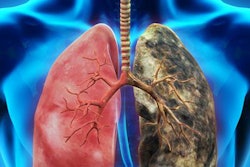
Fresh statistics from the German Lung Cancer Screening Intervention (LUSI) trial have shown that CT lung cancer screening reduced cancer mortality by 69% in high-risk female smokers, but the test offered less of a benefit to men. The results were published online on 4 June in the International Journal of Cancer.
The researchers, led by first author Dr. Nikolaus Becker from the German Cancer Research Center (DKFZ) in Heidelberg, conducted a CT lung screening trial for more than 4,000 eligible smokers throughout Germany. They found that the test helped lower a smoker's risk of lung cancer mortality by 26% for men and women combined, though this overall reduction did not prove to be statistically significant (Int J Cancer, 4 June 2019).
Yet the 26% mortality reduction was the same amount recorded in the Dutch-Belgian Randomized Lung Cancer Screening (NELSON) trial, and greater than the 20% reduction observed in the National Lung Screening Trial (NLST), Becker and colleagues noted.
"The collective evidence from the NELSON and the five smaller European trials, LUSI included, now clearly appears to argue in favor of introducing systematic lung cancer screening in Europe, confirming initial findings from the NLST," they wrote.
CT lung screening in Germany
Since the release of the NLST results nearly a decade ago, several randomized controlled lung cancer screening trials in Europe have confirmed the potential of CT lung screening to reduce cancer mortality risk. Investigators behind the Multicentric Italian Lung Detection (MILD) trial, for instance, have reported a 39% reduction in cancer mortality up to 10 years after baseline screening with CT begins.
Aiming to contribute to the series of European lung screening trials, Becker and colleagues launched a similar large-scale study in Germany in 2007. The German LUSI trial included 4,052 current or former smokers between 50 and 69 years of age with a smoking history of at least 15 pack-years. Roughly two-thirds of the participants were men.
All participants underwent either basic evaluation with no screening or five annual rounds of CT lung screening. Screening was associated with a higher incidence of lung cancer and slightly lower rates of lung cancer mortality and all-cause mortality, though the differences were not statistically significant.
| CT lung cancer screening vs. no screening in the German LUSI trial | ||
| No screening | CT lung screening | |
| Lung cancer incidence rate | 3.31% | 4.19% |
| Lung cancer mortality rate | 1.98% | 1.43% |
| All-cause mortality rate | 7.41% | 7.29% |
The researchers tracked the participants for approximately nine years after initial screening and calculated an overall hazard ratio of 0.74 for lung cancer mortality in the screening cohort, or a decrease in cancer mortality of 26%. Although the reduction did not reach statistical significance (p = 0.21), it nevertheless exceeded the 20% mortality reduction observed in the NLST and matched the 26% mortality reduction in men from the NELSON trial.
The group also found that CT lung screening was associated with a statistically significant increase in early-stage and advanced-stage lung cancer diagnosis -- further highlighting the potential benefits of screening. In addition, the incidence rate of advanced-stage lung cancers dropped by 39% in the screening cohort, compared with the nonscreening cohort.
Screening favors women
What's more, upon dividing the data by sex, the researchers discovered that the reductions in lung cancer mortality were markedly greater for women (hazard ratio = 0.31; p = 0.04) than they were for men (hazard ratio = 0.94; p = 0.81).
| Benefit of CT lung cancer screening for men vs. women | ||
| Men | Women | |
| Reduction in lung cancer mortality risk | 6% | 69% |
This trend toward stronger mortality reduction among women is in line with findings from several European studies including the NELSON trial, the authors noted. Investigators of the NLST have also suggested that differences in cancer mortality reduction could stem from gender differences in susceptibility to different subtypes of non-small cell lung cancer.
Indeed, a much greater proportion of the lung cancers identified in women in the LUSI trial were adenocarcinomas, at 90%, compared with 58% in men, and their relative risks for mortality from adenocarcinomas differed accordingly.
Beyond the NELSON trial, no less than five European trials, including this one, have now demonstrated at least a moderate reduction in lung cancer mortality from CT lung screening for a combined cohort of 17,911 individuals, according to the authors. Still to be determined are the best strategies for risk-stratified recruitment throughout the continent as well as the ideal radiologic criteria for lung cancer diagnosis and nodule management, among other aspects of screening.
"In combination, the pooled European trial data can provide a rich resource to further address these remaining questions, in order to define optimal guidelines for lung cancer screening in Europe," they concluded.



















